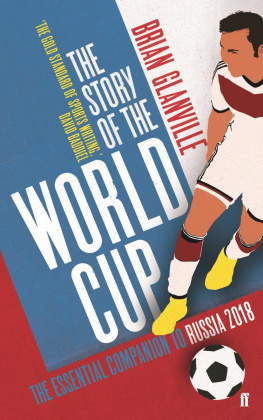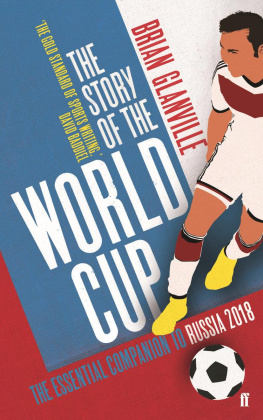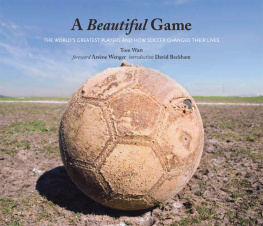The author and publishers are glad to acknowledge the following copyright holders of illustrations reproduced in this book:
URUGUAY
1930
Background to 1930
Like so many of the best ideas in football, that of the World Cup was conceived in France. Its true parents were, indeed, two Frenchmen: Jules Rimet, after whom it was eventually named, and Henri Delaunay. Rimet was President of the French Federation, FFF , for thirty years from its beginning in 1919, and President of FIFA , the Fdration Internationale des Football Associations, from 1920 to 1954; an extraordinary record. Delaunay, who had been concerned with running French football from 1908, was officially Secretary from 1919 till his death in 1956, a little before the death of the 83-year-old Rimet.
These two men complemented each other: Rimet the persuader, the diplomat, sometimes intransigent, always devoted to the game; Delaunay the worker, visionary and energetic. Sometimes they quarrelled, but they were the pioneers of French football, European footballand the World Cup.
The very first meeting of FIFA took place in Paris in 1904without the benefit of British attendanceand decided rather grandly that it alone had the right to organise a world championship. This right was not to be exercised for twenty-six years. In 1920, at FIFAS Antwerp congress, concurrent with the Olympic Games, the idea of a World Cup, previously much debated, was accepted in principle. In 1924, at the Paris Olympics, the FIFA meeting discussed it in more serious detail, while a dazzling and hitherto obscure Uruguayan side walked off with the soccer tournament.
Two years later, at FIFAS congress, Delaunay proclaimed: Today international football can no longer be held within the confines of the Olympics; and many countries where professionalism is now recognised and organised cannot any longer be represented there by their best players.
This had always been true of Britain, which even before the war had been represented by genuine amateurs and which in a couple of years would withdraw from FIFA over the question of broken time payments. Now, it was keeping out such rising countries as Austria and Hungary, while many of those which competed were professionals in all but name. In 1928, in Amsterdam, where Uruguay retained their title against a strong challenge from Argentina, Delaunays resolution that the World Cup be set on foot at once was adopted. But where should it be played?
There were five aspirants: Italy, Holland, Spain, Sweden and Uruguay. Tiny Uruguay, with its proud footballing traditionOther countries have their history, their team manager, Viera, would say at the 1966 World Cup, Uruguay has its footballmade an offer extraordinary for a country of merely two million people. They would pay all travelling and hotel expenses for the visiting teams, and they would build a new stadium for the tournament. It would be in central Montevideo, and would be called the Centenary Stadium, for Uruguay in 1930 would be celebrating a hundred years of independence. It would be built in only eight months, three of which included the rainy season.
The Contenders
Allotted the World Cup at FIFAS 1929 congress in Barcelona, Uruguay found themselves, two months before it was due to kick off, without a single European entrant. In addition to the four we have mentioned, the Austrians, Hungarians, Germans, Swiss and Czechs said no; the British were out of FIFA . Belgium, Romania and Yugoslavia vacillated, as did France, though after Rimets appointment to the FIFA presidency, and Uruguays 1924 appearance in Paris, the moral imperatives were strong.
Embittered, insulted, the Latin American federations threatened to withdraw from FIFA ; a threat they would be making many times in the years to come. Belgium and Romania at last adheredBelgium under the pressure of the veteran FIFA Vice-President, Rodolphe William Seeldrayers, Romania under that of King Carol himself. Though the German-speaking king was never popular in Romania, he had always had much to do with Romanian sport. One of his first acts, on coming to the throne, was to grant an amnesty to all suspended Romanian footballers. Now he picked the Romanian team himself and brought pressure on the companies which employed them to give them time off for Uruguay. Yugoslavia also agreed to go, so there would be four European entrants; but not even by the greatest feat of imagination could they be ranked among the lite. The bitterness in Montevideo was scarcely assuaged.
In the 1924 Olympics Uruguay had thrashed Yugoslavia 70 and France 51. In 1928, Belgium had been beaten by Argentina 63; and now they were travelling without three of their best players, including Bastin.
Argentina, traditional rivals of Uruguay in the Lipton Cup, would be there, however, and would be doughty rivals. In 1928, it had taken a replay before they succumbed 21 in the Olympic Final.
The United States would be there too; moreover, they were one of the teams seeded in the four qualifying pools, which had been set up only when it was realised there wouldnt be enough countries to make a knockout competition possible. At this time there was still professional football of a sort in the States, the rump of the attempt by such as Bethlehem Steel to put the sport on its feet in the 1920s. The American team, managed by Jack Coll of Brooklyn Wanderers, was made up largely of British and Scots pros: Alec Wood, James Gallacher, Andrew Auld, James Brown and Bart McGhee from Scotland, George Moorhouse from England. They were powerfully-built men whom the French players nicknamed the shot-putters.
Brazil were present, but it was not long since the gates had been opened to the black player and the game there was still somewhat in a condition of inspired anarchy. Chile and Mexico, who made up Pool I with Argentina and France; Bolivia, in Pool II with Brazil and Yugoslavia; Peru, in Pool III with Uruguay and Romania; Paraguay, in Pool IV with the USA and Belgium completed the entry of thirteen. The four Pool winners would go into the semi-finals.
Uruguay were unquestionably the favourites, though their fine team of the 1924 and 1928 Olympics was fractionally past its peak; in the image of its famous centre-forward, Pedro Petrone. Nevertheless, it had home advantage and its still abundant talent in its favour, and it is arguable that it would have won the tournament whatever European teams had come, even England, Scotland and the formidable Austrian Wunderteam.
The Earlier Matches
The four European teams, whose boat had picked up the Brazilians en route, were tumultuously welcomed in Montevideo, though none had been seeded head of a group; a distinction reserved for Uruguay, Argentina, Brazil and the USA . The Centenary Stadium was, alas, still unfinished, thanks to heavy rain; early matches had to be played on the grounds of the Penarol and Nacional clubs, Pocito and Central Park. On Sunday afternoon, July 13, France opened the tournament against Mexico with a 41 win; although their admirable and unspectacular goalkeeper, Alex Thpot, was kicked on the jaw after ten minutes, giving way to his left-half, Chantrel. (There would be no substitutes for another forty years.) The French team was a good and lively one, with Etienne Mattler, who would play so well for France for so long, at rightback, Pinel as pivot, and a captain, Alex Villaplane, the right-half, who would ultimately be shot by the French Resistance for collaborating with the Nazis.









